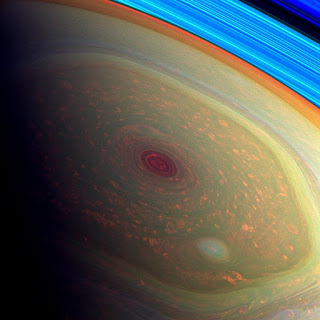Recently I wrote a sad lament for the Schiaparelli Lander, even as I praised those who had successfully
inserted the Trace Gas Orbiter (TGO) into a near-perfect orbit around Mars.
This orbiting communications relay and atmospheric laboratory will serve NASA
scientists for the next several years and will eventually support a European
Space Agency (ESA) rover on the planetary surface. TGO and the Schiaparelli
lander had traveled to the Red Planet together but the lander’s fate was sealed
when its landing rockets fired improperly.
On the other hand,
NASA’s Cassini–Huygens spacecraft was
launched in 1997 and arrived in orbit around Saturn in 2004 where both portions
of the craft performed flawlessy. As planned, the Huygens lander made a
successful touchdown on one of Saturn’s moons (Titan) and transmitted data
throughout the landing and approximately 90 minutes of its initial time on the
surface. This made Huygens the first Earth vehicle to land on the surface of
any planet or moon beyond the asteroid belt of our solar system. Cassini went
on to explore Titan and other moons before settling into an orbit around Saturn.
Since leaving Earth in
1997, Cassini has been an amazing spacecraft. Launched in a time when 1-mega-pixel cameras were state-of-the-art, that was the best high-resolution
camera with which it could be equipped. Now, most cell-phones carry an 8 to 12
mega-pixel camera. Such are the changes that come with a 20-year mission. Cassini
was the first spacecraft to orbit Saturn, and it has been able to map Saturn’s magnetosphere,
has found new Saturnine moons, and studied Saturn’s atmosphere and rings with
greater precision than ever before. But, the space-vehicle is getting old. In
terms of how much space debris, radiation, and other hazards it has seen,
relatively speaking, it is older than the last incarnation of Spock.
Automobiles that are 20 years old and older are often considered antique and show
up in enthusiast’s collections; this 20-year-old vehicle is still out there
serving well.
Numerous remote
repairs, software updates, and “farmer-fixes” have had to be performed on this
machine to keep it on track; and, by the marvels of contemporary engineering,
the technicians at NASA have indeed kept it on its mission. Cassini has two
main engines and is still using its primary engine, but those who work on this
machine had to switch it over to the back-up attitude-control-thrusters when
the first set began to fail several months ago.
There is still an end
of the road for even a highly successful mission like Cassini-Huygens. At the
end of this month, Cassini’s thrusters will maneuver it into a position that
will allow for 22 orbits close to the rings, through gaps between rings, and
finally between the Saturnine atmosphere and the inner-most ring. As a Grand Finale
(a term actually being used for the final days of this spacecraft), Cassini
will plunge into the atmosphere in September of 2017 where it will be vaporized
by the heat of friction and crushed by the pressure of the atmosphere. It will
indeed be a magnificent curtain-call for one of the most successful space
missions of all time.
Links used in
researching this article:
https://saturn.jpl.nasa.gov/news/2947/care-and-feeding-of-an-aging-spacecraft/
An interesting hexagonal polar vortex at the north pole of Saturn:


No comments:
Post a Comment